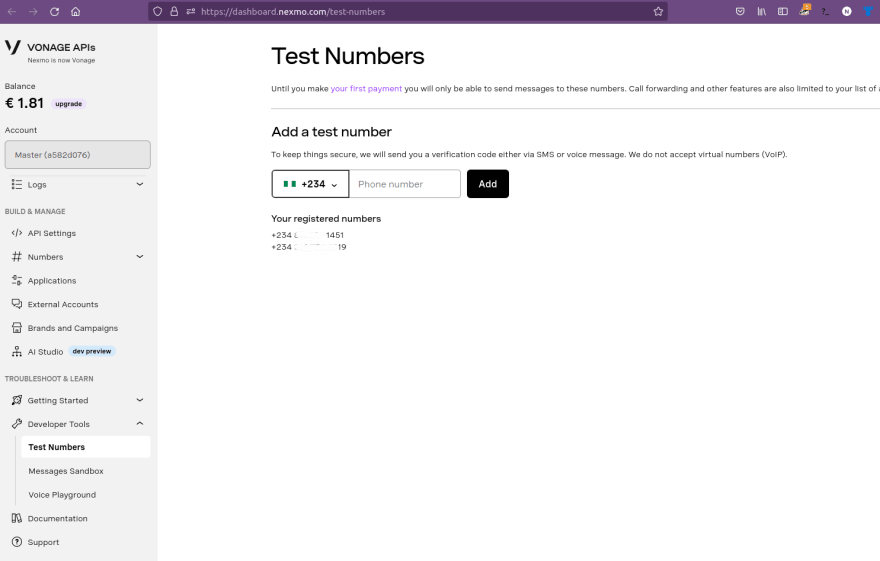This content originally appeared on DEV Community and was authored by Nditah
Send SMS Messages with Node.js using the Vonage API
Clone the Source Code on Github
Vonage is an American telecommunications company headquartered in New Jersey.
The company is a publicly held business cloud based communications provider.
Vonage offers SMS, MMS, Voice, and Video Streaming services via their API gateway.
Vonage's SMS API enables you to send and receive text messages to and from users worldwide, with these features:
- Programmatically send and receive high volumes of SMS globally.
- Send SMS with low latency and high delivery rates.
- Receive SMS using local numbers.
- Scale your applications with familiar web technologies.
- Pay only for what you use, nothing more.
- Auto-redact feature to protect privacy.
The Aim of this project is to create a simple Nodejs RESE API that uses Vonage SMS API
Step 1: Initialize Your Project
Start by initializing a Nodejs project in your project folder, and install the Vonage Server SDK for Node.js in your working directory:
Also install the ExpressJs framework and DotEnv for enviromental virables
$ npm init -y
$ npm install @vonage/server-sdk --save
$ npm i dotenv express
Your package.json will look similar to this:
{
"name": "vonage-sms",
"version": "1.0.0",
"description": "",
"main": "index.js",
"scripts": {
"start": "node index"
},
"keywords": [],
"author": "",
"license": "ISC",
"dependencies": {
"@vonage/server-sdk": "^2.11.1",
"dotenv": "^16.0.1",
"express": "^4.18.1"
},
"type": "module"
}
Add "type": "module" to your package.json file to be able to use import statements.
Step 2: Create two files
lib.js and index.js as shown below:
-
lib.js: a library file for thesendSmsfunction that initializes a Vonage instance with your API credentials
// lib.js
import Vonage from "@vonage/server-sdk";
import 'dotenv/config'
const vonage = new Vonage({
apiKey: process.env.VONAGE_API_KEY,
apiSecret: process.env.VONAGE_API_SECRET,
});
const sender = process.env.VONAGE_VIRTUAL_NUMBER;
export const sendSms = (recipient, message) => {
return new Promise((resolve, reject) => {
console.log("Initial");
vonage.message.sendSms(sender, recipient, message, (err, responseData) => {
if (err) {
console.log(err);
reject(err.message)
} else {
if (responseData.messages[0]["status"] === "0") {
console.dir(responseData);
resolve(responseData);
} else {
console.log(
`Message failed with error: ${responseData.messages[0]["error-text"]}`
);
reject(`${responseData.messages[0]["error-text"]}`);
}
}
}
)
})
};
-
index.js: the main (entry) point for your application.
// index.js
import express from "express";
import 'dotenv/config'
import { sendSms } from "./lib.js";
const PORT = process.env.PORT;
const { json, urlencoded } = express;
const app = express();
app.use(json());
app.use(
urlencoded({
extended: true,
})
);
app.post('/send', (req, res) => {
const { phone, message } = req.body;
sendSms(phone, message)
.then((data) => res.json({ success: true, data }))
.catch((err) => res.json({ success: false, message: err }));
});
app.listen(PORT, () => {
console.log(`Server listening at http://localhost:${PORT}`);
});
Step 3: get and Set your Vonage API Credentials
Next, you will need a Vonage API account. If you don’t have one already, you can sign up and start building with about 2$ free credit.
Find your API key and secret in your Vonage Dashboard and assign them to enviromental variables in .env
PORT=3000
VONAGE_VIRTUAL_NUMBER=GIFTI
VONAGE_API_KEY=abc123
VONAGE_API_SECRET=P1Qxyz000000
Step 4: Configure Sender Virtual Number or Register Recipient Test Number
To get Your Number, click here
- Go to the
Dashboard - Click
Number, then ClickYour Numbers
There, you can manage your virtual phone numbers and configure their settings.
However, for newly signup users, you can only use test numbers because you can only buy more numbers after upgrading to a paid account.
To get Test Numbers, click here
Until you upgrade your account by making your first payment, you will only be able to send messages to these numbers.
Add one or more phone numbers at your disposable. Vonage will send you a verification code either via SMS or voice message.
Step 5: Finally, run your nodejs express application
Open Postman, Insomnia, or any other http client and post to your server
POST Request:
{
"phone": "+234 test-phone",
"message": "Hi Developer, testing for Vonage"
}
POST Response:
{
"success": true,
"data": {
"messages": [
{
"to": "234-test-phone",
"message-id": "866cf22f-c55f-482b-81ba-faa02c69578e",
"status": "0",
"remaining-balance": "1.71020000",
"message-price": "0.09660000",
"network": "62130"
}
],
"message-count": "1"
}
}
If you receive the error message
Non-Whitelisted Destination. Your Vonage account is still in demo mode. While in demo mode you must add target numbers to your whitelisted destination list.
Then know that you need to verify if the recipient phone number is registered as a test-phone number as stated in step-4.
This content originally appeared on DEV Community and was authored by Nditah
Nditah | Sciencx (2022-06-23T11:38:24+00:00) Send SMS Messages with Node.js using the Vonage API. Retrieved from https://www.scien.cx/2022/06/23/send-sms-messages-with-node-js-using-the-vonage-api/
Please log in to upload a file.
There are no updates yet.
Click the Upload button above to add an update.


